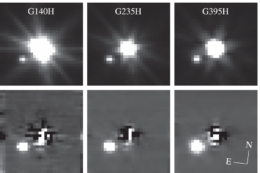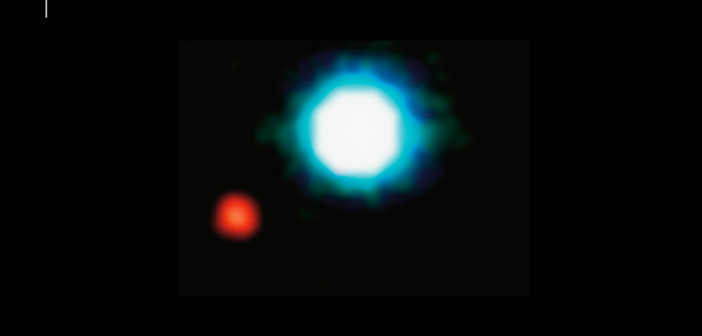Having caught the gigantic, golden eye of JWST several times now, brown dwarfs are having a moment. A new article in The Astrophysical Journal Letters describes the latest planetary-mass companion to take the spotlight, and how our understanding of these mysterious objects is rapidly evolving.
A Popular Runt
Of all the known tiny, barely glowing “failed stars” known to astronomers as brown dwarfs, TWA 27B stands out as a particularly rich target for a number of reasons. As a member of the TW Hydrae association, the youngest group of stars within the nearest few hundred light-years of the Sun, TWA 27B is both exceptionally young and helpfully close by. Also, as a product of the earliest successful campaign to directly image small companions of larger objects, it has the longest track record of observations that can compared with new measurements. Acting on these temptations, JWST took a look at TWA 27B and its slightly larger partner, TWA 27A, in February of this year.

Images of the TWA 27 system created using three different grisms aboard the NIRSpec instrument. The top row shows both objects, while the bottom shows an enhanced view of TWA 27B created by subtracting out its brighter companion. [Luhman et al. 2023]
Methane-Free Zone
For about half an hour, JWST aimed at the TWA 27 system and dutifully collected photons with its onboard Near-Infrared Spectrograph (NIRSpec) instrument across three different wavelength ranges. Piecing the data together back on the ground, a team led by Kevin Luhman, Pennsylvania State University, revealed the atmosphere of a 10 million years young, 5–6-Jupiter-mass object, interestingly devoid of any methane and with only a small whiff of carbon monoxide. Both of these chemical species are common in older brown dwarfs but seem to vanish among younger ones due to non-equilibrium chemistry– a recently noted trend that these observations bolster.

The full 1–5-micron spectrum obtained of TWA 27B, compared to the best-fitting model spectrum derived from a simulation of a cloudless atmosphere. Although the model qualitatively follows the spectrum well, it overpredicts both the strength of the methane absorption and the object’s temperature. The discrepancies might be corrected with a more complex model that includes clouds. [Luhman et al. 2023]
Hungry Brown Dwarf?
Tantalizingly, the team also noticed that while their spectra did not indicate the smoking-gun signatures of a large circumstellar disk (an apparent “excess” of infrared emission), they did reveal that TWA 27B was emitting at specific wavelengths usually associated with accretion. This raises the possibility that the object is still growing slowly, and that it’s ringed by a tiny disk never before inferred over the long and distinguished trail of previous studies.
Thankfully, this cliffhanger provides a possible resolution: if such a disk exists, it will be obvious in observations taken at longer wavelengths. JWST, once again demonstrating its abilities to see what has never before been seen, has already taken these measurements. Data collected with its Mid-Infrared Instrument (MIRI) are being processed now, meaning the flood of unprecedented observations and accompanying discoveries about brown dwarfs is unlikely to stop soon.
Citation
“JWST/NIRSpec Observations of the Planetary Mass Companion TWA 27B,” K. L. Luhman et al 2023 ApJL 949 L36. doi:10.3847/2041-8213/acd635

